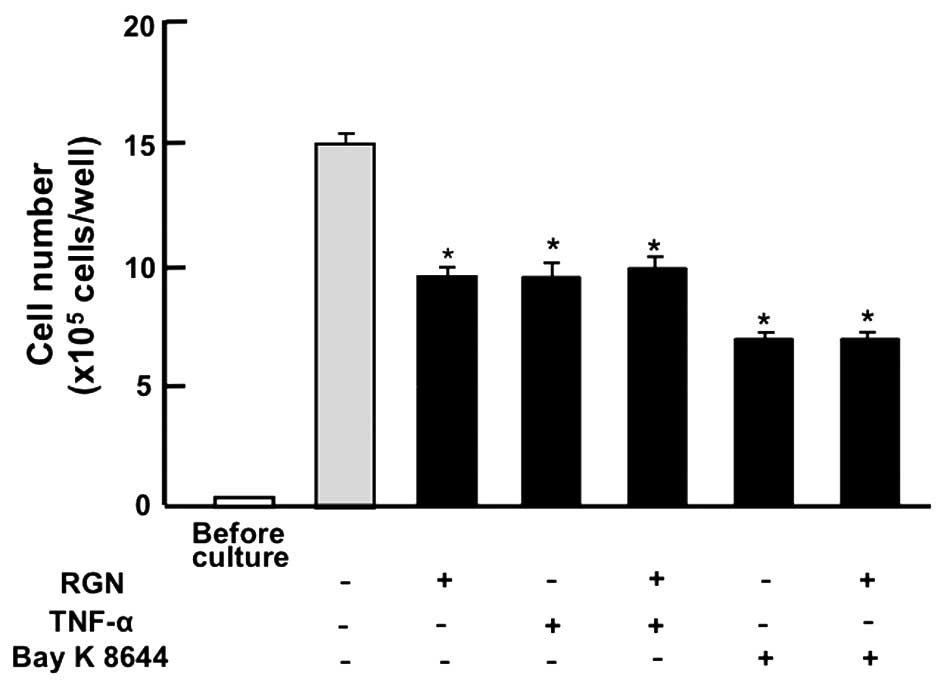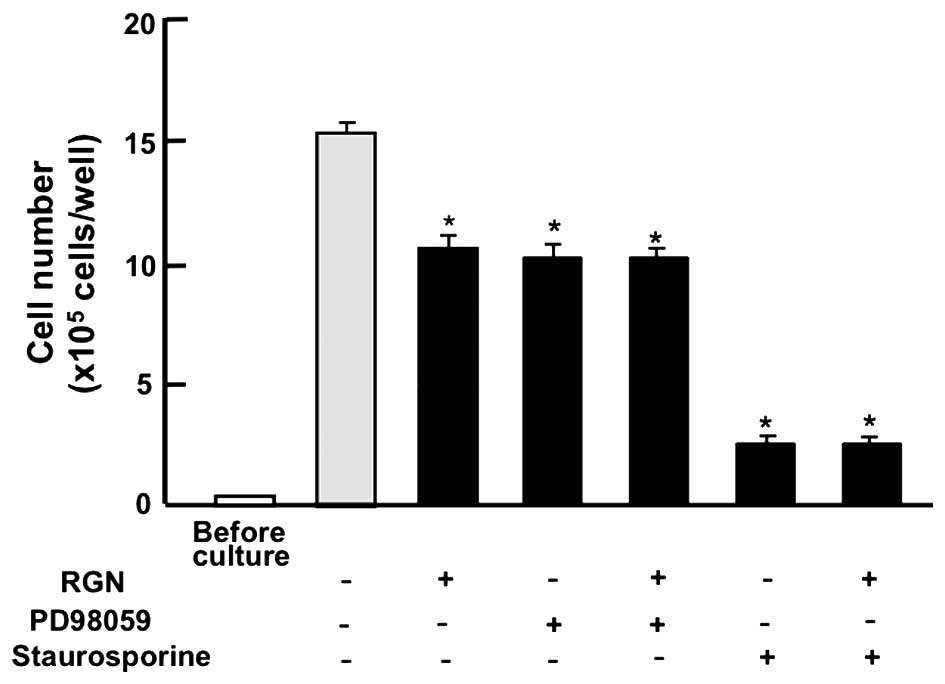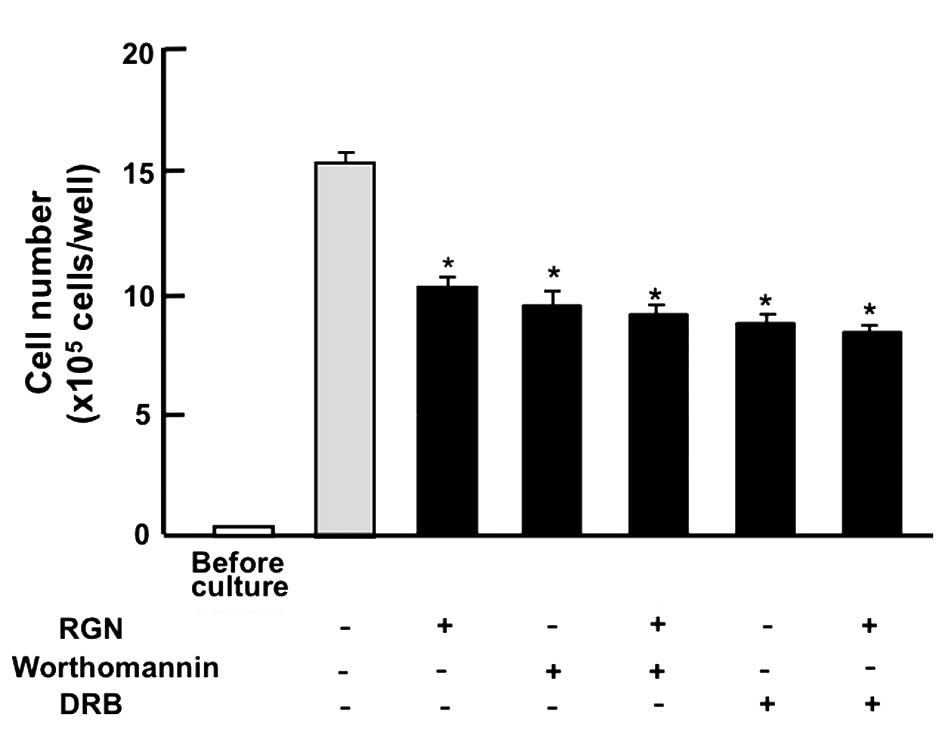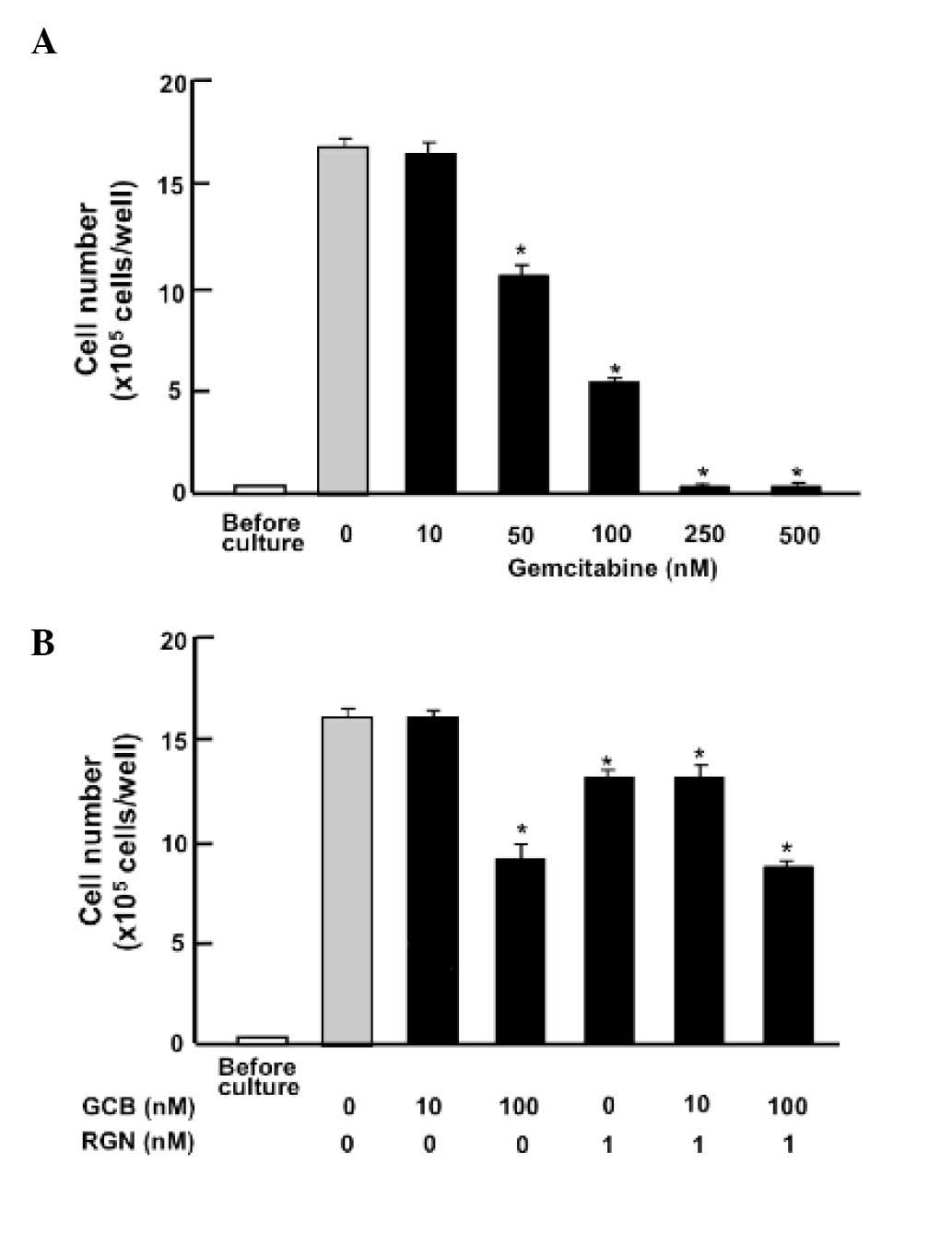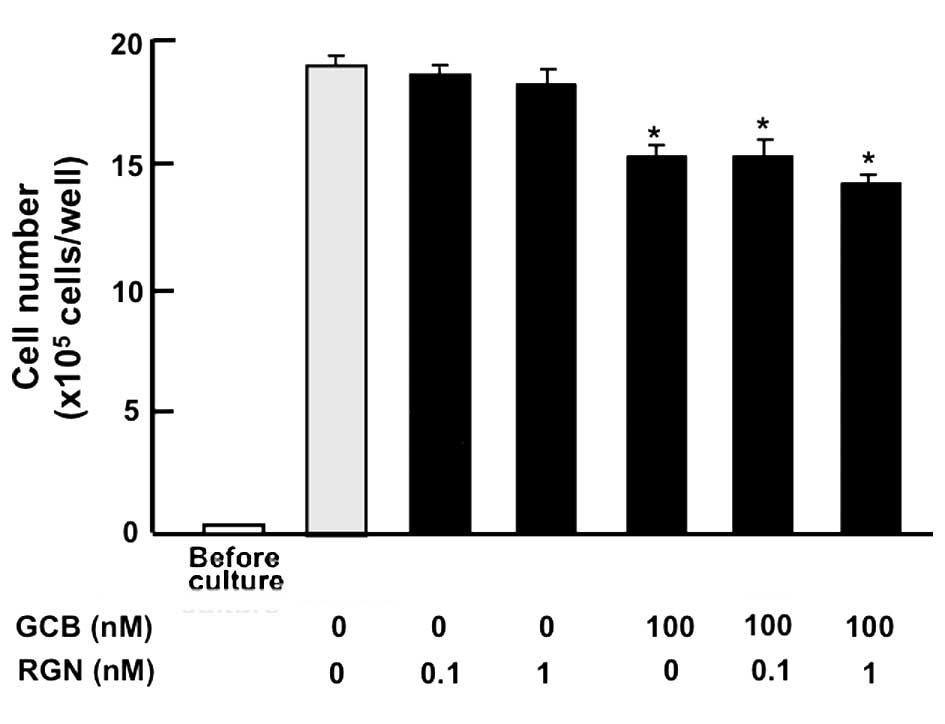Exogenous regucalcin suppresses the proliferation of human breast cancer MDA-MB-231 bone metastatic cells in vitro
Erratum in: /10.3892/mmr.2017.8276
- Authors:
- Published online on: September 23, 2015 https://doi.org/10.3892/mmr.2015.4352
- Pages: 7801-7805
Abstract
Introduction
Regucalcin is a calcium-binding protein which has been demonstrated to serve a multifunctional role in the regulation of various types of cells and tissues (1–6). The regucalcin gene (rgn)), which is located on the X chromosome, is identified in over 15 species consisting of the regucalcin family, and is highly conserved in vertebrate species throughout evolution (7–11). The expression of the regucalcin gene is regulated by various transcription factors including activator protein 1, nuclear factor I-A1, regucalcin gene promoter region-related protein and β-catenin, which are modulated through intracellular signaling factors associated with the phosphorylation and dephosphorylation of nuclear proteins in vitro (11). Regucalcin is expressed in the liver, kidney and various other tissues and is regulated by hormonal factors including calcium-regulating hormones, insulin, estrogen and additional steroid hormones (11,12). Regucalcin is translocated from the cytoplasm to the nucleus in various types of cells (13). Regucalcin has been demonstrated to serve a role in the maintenance of intracellular calcium homeostasis, and it inhibits various protein kinases and phosphatases, in addition to inhibiting protein, DNA and RNA syntheses (3–5,13). Additionally, nuclear regucalcin has been demonstrated to regulate the gene expression of various proteins (13). Furthermore, regucalcin suppresses cell proliferation and apoptotic cell death mediated through various signaling factors in normal kidney NRK52E cells and cloned rat hepatoma H4II-E cells in vitro (14,15). Regucalcin has been proposed to serve a physiological role in maintaining cellular homeostasis and function as a regulatory protein of intracellular signaling systems (5,6).
Regucalcin has been demonstrated to possess a pathophysiological role in metabolic disorders (16–18). In addition, regucalcin has been demonstrated to be involved in carcinogenesis (19). The expression of the regucalcin gene and protein have been demonstrated to be reduced in the tumor tissues of animal models and human patients in vivo (19,20). Regucalcin gene expression has been demonstrated to be downregulated in carcinogenesis, suggesting a potential role of regucalcin as a suppressor protein in carcinogenesis (19). Overexpression of endogenous regucalcin has been previously demonstrated to suppress the enhancement of cell proliferation in cloned rat hepatoma H4-II-E cells in vitro (21).
The aim of the current study was to investigate whether exogenous regucalcin possesses a suppressive effect on the proliferation of human cancer cells in vitro.
Materials and methods
Materials
Dulbecco's modified Eagle's medium (DMEM) with 4.5 g/l glucose, L-glutamine and sodium pyruvate and antibiotics (penicillin and streptomycin; P/S) were purchased from Invitrogen Life Technologies (Carlsbad, CA, USA). Fetal bovine serum (FBS) was purchased from GE Healthcare Life Sciences (Logan, UT, USA). Gemcitabine was obtained from Hospira, Inc. (Lake Forest, IL, USA), and diluted in Dulbecco's modified phosphate-buffered saline (PBS). Tumor necrosis factor-α (TNF-α) was purchased from R&D Systems, Inc. (Minneapolis, MN, USA). PD98059, staurosporine, Bay K8644, wortmannin, 5,6-dichloro-1-β-D-ribofuranosylbenzimidazole (DRB) and all additional reagents were purchased from Sigma-Aldrich (St. Louis, MO, USA) unless otherwise specified.
Regucalcin
Regucalcin was isolated from rat liver cytosol as described previously (1). The livers were perfused with Tris-HCl buffer (pH 7.4), containing 100 mM Tris, 120 mM NaCl and 4 mM KCl, and cooled to 4°C. The livers were subsequently removed, cut into small pieces, suspended 1:4 (w/v) in Tris-HCl buffer (pH 7.4), and homogenized in a Potter-Elvehjem homogenizer (Takashima System Ltd., Tokyo, Japan) with a Teflon pestle (1). The homogenate was spun at 5,500 × g in a refrigerated centrifuge for 10 min, and the supernatant was spun at 105,000 × g for 60 min at 4°C. The resulting supernatant was purified to electrophoretic homogeneity by gel filtration using Sephadex G-75 and G-50, followed by ion-exchange chromatography on diethylaminoethyl-cellulose (4). The purity of the isolated regucalcin was analyzed using gel electrophoresis and western blot analysis, which confirmed that it did not contain other proteins.
Breast cancer MDA-MB-231-bone metastatic cells
Breast cancer MDA-MB-231 bone metastatic cells lack estrogen, progesterone and human epidermal growth factor type 2 receptors, and are therefore considered as triple negative (22). However, the cells express epidermal growth factor, transforming growth factor-α and Wnt7B oncogene, and activation of these receptors and its downstream signaling events enhances the migration, proliferation, invasion and progression of the malignant phenotype of these cells. The MDA-MB-231 bone metastatic cells were provided by Dr Toshi Yoneda (The University of Texas, San Antonio, TX, USA) (22).
Cell proliferation in MDA-MB-231 cells
Breast cancer MDA-MB-231 cells (1×105/ml per well) were cultured in a 24-well plate in DMEM containing 10% FBS and 1% P/S in the presence or absence of regucalcin (0.01, 0.1, 05, 1 or 10 nM) for 1, 2, 3 and 7 days. In separate experiments, MDA-MB-231 cells (1×105/ml per well) were cultured in DMEM containing 10% FBS and 1% P/S in the presence of TNF-α (1 ng/ml), Bay K8644 (1 µM), PD98059 (1 µM), staurosporine (0.1 µM), wortmannin (1 µM) or DRB (1 µM) for 3 days. Following culture, the number of cells was counted.
Cell death in MDA-MB-231 cells
Breast cancer MDA-MB-231 cells (1×105/ml per well) were cultured in a 24-well plate in DMEM containing 10% FBS and 1% P/S in the absence of regucalcin for 7 days, until cells were confluent. Subsequently, the cells were cultured in the presence or absence of regucalcin (0.1, 1 or 10 nM) with or without gemcitabine (10, 50, 100, 250, and 1,000 nM) for 7 days. Following culture, the number of cells was counted.
Cell counting
Following trypsinization of each culture dish in 0.2% trypsin with 0.02% EDTA in Ca2+/Mg2+-free PBS for 2 min at 37°C, the detached cells were collected by centrifugation at 12 × g for 5 min at 4°C (Eppendorf 5810 R). The cells were resuspended in PBS solution and stained with eosin. Cell numbers were counted under a microscope (Olympus MTV-3; Olympus Corporation, Tokyo, Japan) using a hemocytometer (Brightline; Sigma-Aldrich). For each dish, the cells were counted twice from which the average was calculated. Cell numbers are presented as the number/well of plate.
Statistical analysis
Data are presented as the mean ± standard deviation. Statistical significance was determined using GraphPad InStat software, version 3 (GraphPad Software, Inc., La Jolla, CA, USA). Multiple comparisons were conducted using a one-way analysis of variance and a Tukey-Kramer multiple comparisons post-test for parametric data. P<0.05 was considered to indicate a statistically significant difference.
Results
The effect of exogenous regucalcin on the proliferation of breast cancer MDA-MB-231 bone metastatic cells in vitro is presented in Fig. 1. MDA-MB-231 cells were cultured in the presence of exogenous regucalcin (0.1–10 nM) for 1–7 days. The number of cells increased with the increasing duration of culture. The addition of exogenous regucalcin reduced the increase in cell number, indicating that cell proliferation was suppressed by the physiological concentrations of serum regucalcin (23).
The suppressive effects of regucalcin (1 nM) on cell proliferation in MDA-MB-231 cells were not enhanced in the presence of TNF-α (1 ng/ml), an enhancer of nuclear factor-κB (NF-κB) signaling (24) or Bay K8644 (1 µM), an agonist of Ca2+ influx in cells (25), which resulted in significantly reduced cell numbers when applied alone (Fig. 2). In addition, the effects of exogenous regucalcin in reducing cell proliferation were not enhanced in the presence of PD98059 (1 µM), a mitogen-activated protein kinase (MAPK) inhibitor (26) or staurosporine (0.1 µM), an inhibitor of protein kinase C (27), which caused a significant reduction in cell numbers (Fig. 3). Furthermore, the suppressive effects of regucalcin on cell proliferation were not enhanced in the presence of wortmannin (1 µM), an inhibitor of phosphatidylinositol 3-kinase (PI3K) (28) or DRB (1 µM), an inhibitor of transcriptional activity via RNA polymerase II inhibition (29) (Fig. 4).
The suppressive effects of regucalcin on the proliferation of MDA-MB-231 cells were investigated in the presence of gemcitabine, an antitumor agent, which induces nuclear DNA damage (30). The addition of gemcitabine (50–500 nM) to MDA-MB-231 cultures reduced cell proliferation (Fig. 5A). This effect was not altered by the application of regucalcin (1 nM) with gemcitabine (Fig. 5B). The addition of regucalcin (1 nM) significantly reduced cell numbers in the presence of gemcitabine (10 nM).
The effect of regucalcin on cell death in breast cancer MDA-MB-231 cells is presented in Fig. 6. Cells were cultured for 7 days until confluent, and subsequently cultured for 7 days in the presence of regucalcin (0.1 or 1 nM) with or without gemcitabine (100 nM). The addition of regucalcin was not observed to significantly affect the cell number, however culture with gemcitabine reduced cell number. Therefore, it is suggested that regucalcin does not induce cell death.
Discussion
Regucalcin has been demonstrated to serve a multifunctional role in the regulation of cell function by suppressing various signaling pathways in various types of cells and tissues (4–6). Previous studies have demonstrated that regucalcin serves a potential role as a suppressor of cell proliferation and carcinogenesis (14,18,19). Regucalcin gene expression was observed to be downregulated in the tumor tissues of human patients (20) and in human cancer cells (18,31). The current study demonstrated that exogenous regucalcin possesses suppressive effects on the proliferation of human breast cancer MDA-MB-231 bone metastatic cells in vitro, however was not observed to affect cell death.
Overexpression of endogenous regucalcin has been demonstrated to suppress the proliferation of cloned rat hepatoma H4-II-E cells in vitro (14,18,21). Regucalcin has been demonstrated to result in G1 and G2/M phase cell cycle arrest in H4-II-E cells (32). In addition, overexpression of endogenous regucalcin has been demonstrated to have suppressive effects on cell proliferation inducing G1 and G2/M phase cell cycle arrest in cloned normal rat kidney proximal tubular epithelial NRK52E cells in vitro (33). The suppressive effects of endogenous regucalcin on cell proliferation may be mediated through the inhibition of various Ca2+ signaling-dependent protein kinases, protein phosphatases and PI3K activities and the suppression of c-Myc, H-Ras, c-Jun and chk2 mRNA expression, or the enhancement of p53 and Rb mRNA expression (14,19,34,35). Furthermore, regucalcin has been demonstrated to suppress cytoplasmic protein synthesis and nuclear DNA and RNA synthesis (13,14).
The current study demonstrated that the suppressive effects of exogenous regucalcin on the proliferation of MDA-MB-231 cells were not modulated in the presence of various inhibitors that regulate intracellular signaling pathways in vitro. The suppressive effects of regucalcin on the proliferation of MDA-MB-231 cells were not enhanced in the presence of: TNF-α, an enhancer of NF-κB signaling (24); Bay K8644, an agonist of Ca2+ entry in cells (25); PD98059, an MAPK inhibitor (26); staurosporine, an inhibitor of calcium-dependent protein kinase C (27); or wortmannin, an inhibitor of PI3K (28). These data suggest that exogenous regucalcin stimulates various intracellular signaling pathways to suppress cell proliferation in human breast cancer MDA-MB-231 cells. Regucalcin has been demonstrated to bind the plasma membranes of rat liver cells in vitro (36). Therefore, it may be possible that exogenous regucalcin binds to the plasma membranes of breast cancer MDA-MB-231 cells, and potentially regulates intracellular signaling pathways that suppress cell proliferation. In addition, the suppressive effects of regucalcin on cell proliferation were not enhanced in the presence of DRB, an inhibitor of transcriptional activity via RNA polymerase II inhibition (29). The intracellular signals of exogenous regucalcin may be transmitted into the nucleus to suppress transcriptional regulation in human breast cancer MDA-MB-231 cells.
Overexpression of endogenous regucalcin has been demonstrated to have suppressive effects on apoptotic cell death in rat hepatoma H4-II-E cells and normal rat kidney NRK52-E cells, which were increased through various signaling pathways in the cytoplasm and nucleus in vitro (15). In the current study, exogenous regucalcin did not induce cell death in human breast cancer MDA-MB-231 cells in vitro, indicating that regucalcin does not stimulate cell death. This effect was not enhanced in the presence of gemcitabine, an antitumor agent, which induces nuclear DNA damage (30). This observation may support the theory that the intracellular signaling by exogenous regucalcin may be transmitted to regulate nuclear function in breast cancer cells.
In conclusion, the current study demonstrated that exogenous regucalcin possesses suppressive effects on the proliferation of human breast cancer MDA-MB-231 bone metastatic cells in vitro. This suggests that exogenous regucalcin serves a role as a suppressor of the proliferation of human cancer cells.
References
|
Yamaguchi M and Yamamoto T: Purification of calcium binding substance from soluble fraction of normal rat liver. Chem Pharm Bull (Tokyo). 26:1915–1918. 1978. View Article : Google Scholar | |
|
Yamaguchi M and Sakurai T: Inhibitory effect of calcium-binding protein regucalcin on Ca2(+)-activated DNA fragmentation in rat liver nuclei. FEBS Lett. 279:281–284. 1991. View Article : Google Scholar : PubMed/NCBI | |
|
Shimokawa N and Yamaguchi M: Molecular cloning and sequencing of the cDNA coding for a calcium-binding protein regucalcin from rat liver. FEBS Lett. 327:251–255. 1993. View Article : Google Scholar : PubMed/NCBI | |
|
Yamaguchi M: Role of regucalcin in calcium signaling. Life Sci. 66:1769–1780. 2000. View Article : Google Scholar : PubMed/NCBI | |
|
Yamaguchi M: Role of regucalcin in maintaining cell homeo-stasis and function (review). Int J Mol Med. 15:371–389. 2005.PubMed/NCBI | |
|
Yamaguchi M: Regucalcin and cell regulation: Role as a suppressor protein in signal transduction. Mol Cell Biochem. 353:101–137. 2011. View Article : Google Scholar : PubMed/NCBI | |
|
Shimokawa N, Matsuda Y and Yamaguchi M: Genomic cloning and chromosomal assignment of rat regucalcin gene. Mol Cell Biochem. 151:157–163. 1995. View Article : Google Scholar : PubMed/NCBI | |
|
Thiselton DL, McDowall J, Brandau O, Ramser J, d'Esposito F, Bhattacharya SS, Ross MT, Hardcastle AJ and Meindl A: An integrated, functionally annotated gene map of the DXS8026-ELK1 interval on human Xp11.3-Xp11.23: Potential hotspot for neurogenetic disorders. Genomics. 79:560–572. 2002. View Article : Google Scholar : PubMed/NCBI | |
|
Yamaguchi M, Makino R and Shimokawa N: The 5′ end sequences and exon organization in rat regucalcin gene. Mol Cell Biochem. 165:145–150. 1996. View Article : Google Scholar : PubMed/NCBI | |
|
Misawa H and Yamaguchi M: The gene of Ca2+-binding protein regucalcin is highly conserved in vertebrate species. Int J Mol Med. 6:191–196. 2000.PubMed/NCBI | |
|
Yamaguchi M: The transcriptional regulation of regucalcin gene expression. Mol Cell Biochem. 346:147–171. 2011. View Article : Google Scholar | |
|
Yamaguchi M: Hormonal Regulation of regucalcin gene expression: Involvement in cell metabolism. Horm Stud. 1:12013. View Article : Google Scholar | |
|
Yamaguchi M: Role of regucalcin in cell nuclear regulation: Involvement as a transcription factor. Cell Tissue Res. 354:331–341. 2013. View Article : Google Scholar : PubMed/NCBI | |
|
Yamaguchi M: Suppressive role of regucalcin in liver cell proliferation: Involvement in carcinogenesis. Cell Prolif. 46:243–253. 2013. View Article : Google Scholar : PubMed/NCBI | |
|
Yamaguchi M: The anti-apoptotic effect of regucalcin is mediated through multisignaling pathways. Apoptosis. 18:1145–1153. 2013. View Article : Google Scholar : PubMed/NCBI | |
|
Yamaguchi M: Regucalcin and metabolic disorder: Osteoporosis and hyperlipidemia are induced in regucalcin transgenic rats. Mol Cell Biochem. 341:119–133. 2010. View Article : Google Scholar : PubMed/NCBI | |
|
Yamaguchi M and Murata T: Involvement of regucalcin in lipid metabolism and diabetes. Metabolism. 62:1045–1051. 2013. View Article : Google Scholar : PubMed/NCBI | |
|
Yamaguchi M: Regucalcin as a potential biomarker for metabolic and neuronal diseases. Mol Cell Biochem. 391:157–166. 2014. View Article : Google Scholar : PubMed/NCBI | |
|
Yamaguchi M: Involvement of regucalcin as a suppressor protein in human carcinogenesis: Insight into the gene therapy. J Cancer Res Clin Oncol. 141:1333–1341. 2015. View Article : Google Scholar | |
|
Murata T and Yamaguchi M: Alternatively spliced variants of the regucalcin gene in various human normal and tumor tissues. Int J Mol Med. 34:1141–1146. 2014.PubMed/NCBI | |
|
Misawa H, Inagaki S and Yamaguchi M: Suppression of cell proliferation and deoxyribonucleic acid synthesis in the cloned rat hepatoma H4-II-E cells overexpressing regucalcin. J Cell Biochem. 84:143–149. 2001. View Article : Google Scholar : PubMed/NCBI | |
|
Hiraga T, Williams PJ, Mundy GR and Yoneda T: The bisphosphonate ibandronate promotes apoptosis in MDA-MB-231 human breast cancer cells in bone metastases. Cancer Res. 61:4418–4424. 2001.PubMed/NCBI | |
|
Yamaguchi M and Isogai M: Tissue concentration of calcium-binding protein regucalcin in rats by enzyme-linked immunoadsorbent assay. Mol Cell Biochem. 122:65–68. 1993. View Article : Google Scholar : PubMed/NCBI | |
|
Lee ZH, Kwack K, Kim KK, Lee SH and Kim HH: Activation of c-Jun N-terminal kinase and activator protein 1 by receptor activator of nuclear factor kappaB. Mol Pharmacol. 58:1536–1545. 2000.PubMed/NCBI | |
|
Cano-Abad MF, Villarroya M, García AG, Gabilan NH and López MG: Calcium entry through L-type calcium channels causes mitochondrial disruption and chromaffin cell death. J Biol Chem. 276:39695–39704. 2001. View Article : Google Scholar : PubMed/NCBI | |
|
Chen S, Wang Y, Ruan W, Wang X and Pan C: Reversing multidrug resistance in hepatocellular carcinoma cells by inhibiting extracellular signal-regulated kinase/mitogen-activated protein kinase signaling pathway activity. Oncol Lett. 8:2333–2339. 2014.PubMed/NCBI | |
|
Chen QW, Edvinsson L and Xu CB: Role of ERK/MAPK in endothelin receptor signaling in human aortic smooth muscle cells. BMC Cell Biol. 10:522009. View Article : Google Scholar : PubMed/NCBI | |
|
Serrano-Nascimento C, da Silva Teixeira S, Nicola JP, Nachbar RT, Masini-Repiso AM and Nunes MT: The acute inhibitory effect of iodide excess on sodium/iodide symporter expression and activity involves the PI3K/Akt signaling pathway. Endocrinology. 155:1145–1156. 2014. View Article : Google Scholar : PubMed/NCBI | |
|
Palangat M, Grass JA, Langelier MF, Coulombe B and Landick R: The RPB2 flap loop of human RNA polymerase II is dispensable for transcription initiation and elongation. Mol Cell Biol. 31:3312–3325. 2011. View Article : Google Scholar : PubMed/NCBI | |
|
Tang SC and Chen YC: Novel therapeutic targets for pancreatic cancer. World J Gastroenterol. 20:10825–10844. 2014. View Article : Google Scholar : PubMed/NCBI | |
|
Maia C, Santos C, Schmitt F and Socorro S: Regucalcin is under-expressed in human breast and prostate cancers: Effect of sex steroid hormones. J Cell Biochem. 107:667–676. 2009. View Article : Google Scholar : PubMed/NCBI | |
|
Yamaguchi M and Daimon Y: Overexpression of regucalcin suppresses cell proliferation in cloned rat hepatoma H4-II-E cells: Involvement of intracellular signaling factors and cell cycle-related genes. J Cell Biochem. 95:1169–1177. 2005. View Article : Google Scholar : PubMed/NCBI | |
|
Nakagawa T, Sawada N and Yamaguchi M: Overexpression of regucalcin suppresses cell proliferation of cloned normal rat kidney proximal tubular epithelial NRK52E cells. Int J Mol Med. 16:637–643. 2005.PubMed/NCBI | |
|
Tsurusaki Y and Yamaguchi M: Overexpression of regucalcin modulates tumor-related gene expression in cloned rat hepatoma H4-II-E cells. J Cell Biochem. 90:619–626. 2003. View Article : Google Scholar : PubMed/NCBI | |
|
Tsurusaki Y and Yamaguchi M: Role of regucalcin in liver nuclear function: Binding of regucalcin to nuclear protein or DNA and modulation of tumor-related gene expression. Int J Mol Med. 14:277–281. 2004.PubMed/NCBI | |
|
Yamaguchi M, Mori S and Kato S: Calcium-binding protein regucalcin is an activator of (Ca2+-Mg2+)-adenosine triphosphatase in the plasma membranes of rat liver. Chem Pharm Bull (Tokyo). 36:3532–3539. 1988. View Article : Google Scholar |




